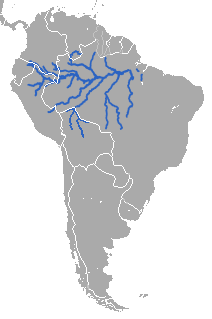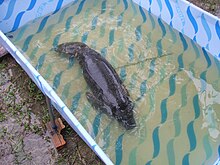
Manatees are large, fully aquatic, mostly herbivorous marine mammals sometimes known as sea cows. There are three accepted living species of Trichechidae, representing three of the four living species in the order Sirenia: the Amazonian manatee, the West Indian manatee, and the West African manatee. They measure up to 4.0 metres long, weigh as much as 590 kilograms (1,300 lb), and have paddle-like tails.

The Sirenia, commonly referred to as sea cows or sirenians, are an order of fully aquatic, herbivorous mammals that inhabit swamps, rivers, estuaries, marine wetlands, and coastal marine waters. The extant Sirenia comprise two distinct families: Dugongidae and Trichechidae with a total of four species. The Protosirenidae and Prorastomidae families are extinct. Sirenians are classified in the clade Paenungulata, alongside the elephants and the hyraxes, and evolved in the Eocene 50 million years ago (mya). The Dugongidae diverged from the Trichechidae in the late Eocene or early Oligocene.
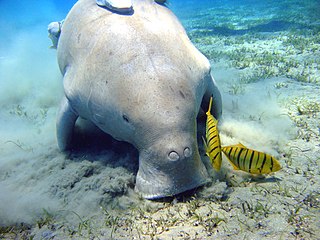
Dugongidae is a family in the order of Sirenia. The family has one surviving species, the dugong, one recently extinct species, Steller's sea cow, and a number of extinct genera known from fossil records.

Trichechidae is a family of sirenians that includes all living manatees and several extinct genera.

The Desmostylia are an extinct order of aquatic mammals native to the North Pacific from the early Oligocene (Rupelian) to the late Miocene (Tortonian). Desmostylians are the only known extinct order of marine mammals.

Hydrodamalis is a genus of extinct herbivorous sirenian marine mammals, and included the Steller's sea cow, the Cuesta sea cow, and the Takikawa sea cow. The fossil genus Dusisiren is regarded as the sister taxon of Hydrodamalis: together, the two genera form the dugong subfamily Hydrodamalinae. They were the largest member of the order Sirenia, whose only extant members are the dugong and the manatees. They reached up to 9 metres (30 ft) in length, making the Steller's sea cow among the largest mammals other than whales to have existed in the Holocene epoch. Steller's sea cow was first described by Georg Wilhelm Steller,

The African manatee, also known as the West African manatee, is a species of manatee that inhabits much of the western region of Africa – from Senegal to Angola. It is the only manatee species to be found in the Old World.

The West Indian manatee, also known as the North American manatee, is a large, aquatic mammal native to warm coastal areas of the Caribbean, from the eastern US to northern Brazil. Living alone or in herds, it feeds on underwater plants and uses its whiskers to navigate. It is divided into two endangered subspecies, the Florida manatee in the US and the Antillean manatee in the Caribbean, both of which face pressure from habitat loss, pollution, and other human activity. The West Indian manatee is the largest living member of the sirenians, a group of large aquatic mammals that includes the dugong, other manatees, and the extinct Steller's sea cow.

Aquatic and semiaquatic mammals are a diverse group of mammals that dwell partly or entirely in bodies of water. They include the various marine mammals who dwell in oceans, as well as various freshwater species, such as the European otter. They are not a taxon and are not unified by any distinct biological grouping, but rather their dependence on and integral relation to aquatic ecosystems. The level of dependence on aquatic life varies greatly among species. Among freshwater taxa, the Amazonian manatee and river dolphins are completely aquatic and fully dependent on aquatic ecosystems. Semiaquatic freshwater taxa include the Baikal seal, which feeds underwater but rests, molts, and breeds on land; and the capybara and hippopotamus which are able to venture in and out of water in search of food.

Halitherium is an extinct dugongid sea cow that arose in the late Eocene, then became extinct during the early Oligocene. Its fossils are common in European shales. Inside its flippers were finger bones that did not stick out. Halitherium also had the remnants of back legs, which did not show externally. However, it did have a basic femur, joined to a reduced pelvis. Halitherium also had elongated ribs, presumably to increase lung capacity to provide fine control of buoyancy. A 2014 review presented the opinion that the genus is dubious.

Sirenia is the order of placental mammals which comprises modern "sea cows" and their extinct relatives. They are the only extant herbivorous marine mammals and the only group of herbivorous mammals to have become completely aquatic. Sirenians are thought to have a 50-million-year-old fossil record. They attained modest diversity during the Oligocene and Miocene, but have since declined as a result of climatic cooling, oceanographic changes, and human interference. Two genera and four species are extant: Trichechus, which includes the three species of manatee that live along the Atlantic coasts and in rivers and coastlines of the Americas and western Africa, and Dugong, which is found in the Indian and Pacific oceans.
The dwarf manatee is a disputed species of manatee allegedly found in the freshwater habitats of the Amazon, though restricted to one tributary of the Aripuanã River. According to Marc van Roosmalen, the scientist who proposed it as a new species, it lives in shallow, fast-running water, and feeds on different species of aquatic plants from the Amazonian manatee, which prefers deeper, slower-moving waters and the plants found there. The dwarf manatee reportedly migrates upriver during the rainy season when the river floods to the headwaters and shallow ponds. Based on its small range, the dwarf manatee is suggested to be considered critically endangered if indeed a separate species, but is not recognized by the IUCN.
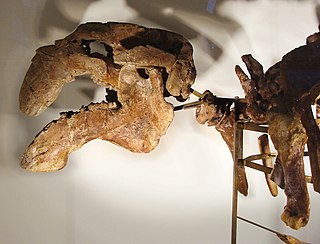
Eotheroides is an extinct genus of Eocene sirenian. It is an early member of the family Dugongidae, which includes the extant dugong. Fossils have been found from Egypt, India, and Madagascar. Eotheroides was first described by Richard Owen in 1875 under the name Eotherium, which was replaced by the current name in 1899.
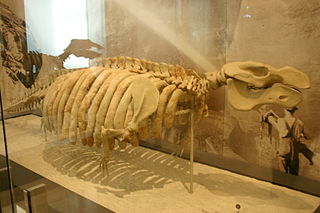
Metaxytherium is an extinct genus of dugong that lived from the Oligocene until the end of the Pliocene. Fossil remains have been found in Africa, Europe, North America and South America. Generally marine seagrass specialists, they inhabited the warm and shallow waters of the Paratethys, Mediterranean, Caribbean Sea and Pacific coastline. American species of Metaxytherium are considered to be ancestral to the North Pacific family Hydrodamalinae, which includes the giant Steller's sea cow.
Protosiren is an extinct early genus of the order Sirenia. Protosiren existed throughout the Lutetian to Priabonian stages of the Middle Eocene. Fossils have been found in the far-flung locations like the United States, Africa (Egypt), Europe and Asia.

Nanosiren garciae is an extinct sirenian dugong that lived in warm shallow seas in what is now Venezuela, approximately 11.610—3.6 Ma during the Miocene and Pliocene. The species is listed in the Paleobiology Database, funded by the Australian Research Council.
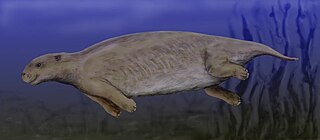
Prorastomidae is a family of extinct sirenians from Jamaica, related to the extant manatees and dugong. The family includes the oldest known fossils of Sirenians, represented in two genera:

The Caribbean Manatee Conservation Center is a research, education, rescue, and rehabilitation partnership established in 2009 in the Caribbean island of Puerto Rico in order to help endangered manatees survive from extinction.

Trichechus hesperamazonicus, the western Amazonian manatee, is an extinct species of manatee that lived about 40 thousand years ago in the Madeira River, in the Brazilian state of Rondonia. It is known from this single locality, with possible occurrences in the Brazilian state of Acre.
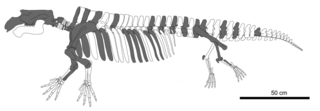
Sobrarbesiren is a genus of extinct sirenian that lived in the Eocene, about 47 million years ago. The type and only species is S. cardieli, known from a multitude of specimens from the Spanish Pyrenees. Sobrarbesiren was a medium-sized animal, 2.7 m long and still retaining both pairs of limbs. Although initially thought to be amphibious, later studies instead suggest that they would have been fully aquatic and been selective sea grass browsers. Unlike modern dugongs and manatees, they likely lacked a tail fluke, although it would have appeared horizontally flattened.

